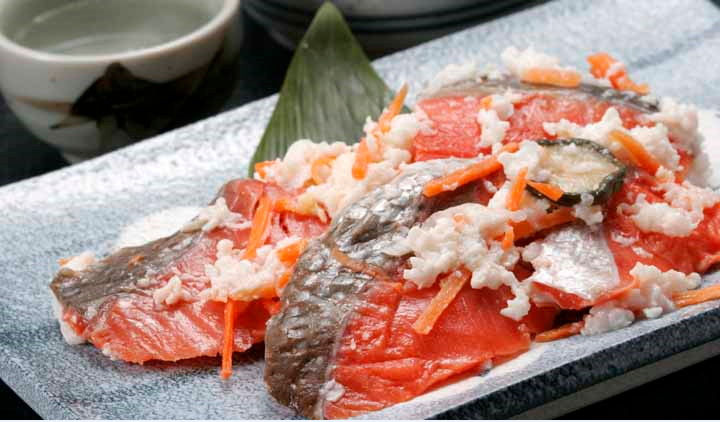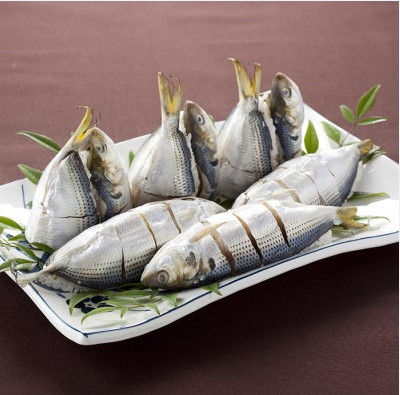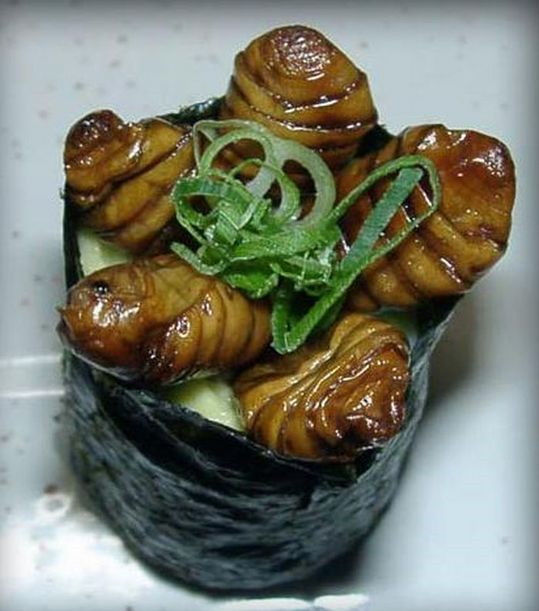Various Sushis in Japan
- japan-desu
- 2016年12月30日
- 読了時間: 4分
Various types of sushi in Japan will be introduced.
Hokkaido

I Sushi 飯寿司
I-sushi is made by fermentation of yeast, fish, and vegetable put together.
This was used as a way to preserve food during winter and now became necessary traditional local food to celebrate year-end and New Year.
It can be eaten as side dish for meal or snack served with alcohol. It can be found not only in Hokkaido but also in northern shore of Honshu.


Nemuro Sanmaru Roll Sushi 根室のサンマロール寿司
Saomaedashima can be cultivated during only 40 days out of whole year.
It is used with kelp and vinegar to bring out the taste and rolled with sesame leaf, sesame, green onion, and etc.


Akita

Hana Sushi 花寿司
This is a traditional tsukemono(pickled things) from current Akita area.
It is made by piling layers of eggplants, yeast, and chrysanthemum. In order to prolonged preservation, great amount of salt used to be used.
Nowadays, less salted Hanasushi is more commonly made for easier consumption.
This Hanasushi can accommodate both meals and drinks.


Hatahata Sushi はたはた寿司
This is Hatahata, rice, vegetable, and yeast put together and fermented.
This traditional food was made to be preserved during harsh winter of Akita.
It is often served as a New-year food, and it is popular as a gift nowadays.

Chiba

Hishiko Oshi Sushi ひしこ押し寿司
This is sushi made of anchovy.
This fish is hard to cook as it does not have much meat but yet has a lot of bones.
It tastes better without soaking into soy sauce while putting only wasabi.

Futomaki Sushi 太巻き寿司
This is made by putting sushi, kanpyo, mushroom, carrot, and various seasonal vegetables rolled by seaweed or rolled omelet.
The distinct feature of the food is drawings of flower, animal, or other things on the cutting surface of sushi. It is popular for kids’ lunch box.


Nagano

Sasa Sushi 笹寿司
This is told to be a gift from people of Tomura to Uesugi Shingen during Sengoku period as a field meal.
This simple sushi contains bracken, walnut, and mushroom and put on a bamboo leaf. The sushi is prepared in a way that usage of chopstick is not necessary.
In Nagano, it is a custom to prepare and eat Sasasushi when celebrating.


Toyama

Masu Sushi ます寿し
Bone is removed from masu(trout). Masu meat and sushi are stacked and surrounded by bamboo leaf.
It is pressed by a wooden barrel, so cake-like feature is made.
The taste is not uniform as there are various tastes of Masuzushi such as sweet, sour, salty, and etc.


Ishikawa

Sasa-Sushi 笹寿司
This is bamboo leaf wrapped Oshizushi(pushed sushi).
Sardine is used during spring and mackerel or abalone during fall. Sometimes dried shrimp is used as toppings.
These days, they are even sold in supermarkets.
So, it is possible to eat anytime if you live in Ishikawa Prefecture.


Kabura Sushi かぶら寿し
Kaburazushi was designed to be a gift to a samurai from fish dealers. Salted Hamachi (yellowtail) is wrapped by kabura then soaked in amasake.

Aichi

Morokono-Hakosushi もろこの箱寿司
Small fish called moroko is boiled down with sugar added soy sauce.
The fish then is put on sushi and pressed by wooden box to make a rectangular shape.
There are not many places that make this sushi today, and it is rare to get a chance to taste. Hako means box in Japanese.

Shiga

Funa sushi ふな寿司
This sushi comes with terrible smell, but there are many enthusiastic fans.
Big sized koi (carp) is used.
Usually female carps are used while removing all the organs except the part with eggs. Salt is added on that empty space and fermented for about 3 months.
It is said that there are funazushi with fermentation period of 2 years.


Mie

Mehari sushi めはり寿司
Big onigiri (rice ball) topped with Takana’s tsukemono (pickled things). Originally, it used to be farmers’ food, but today it is popular for tourists’ food as well.


Nara

Kakinoha-Sushi 柿の葉すし
The smell of persimmon leaf and perfect amount of sourness bring out appetite.
Kakinohasushi is made by putting fish on sushi and wrapped by persimmon leaf.
Three types of fish are usually used – mackerel, sake (salmon), and tai (red snapper).


Kyoto

Konoshiro-Sushi このしろ寿司
Konoshirosushi is one of the house foods in this area. Fresh caught konosiro fish from Kumihamawan is used as whole.
This famous sushi always appears during fall festivals.


Bara-Sushi ばら寿司
Barasushi is called chirashisushi in Kanto region.
This is one of the local dishes that always show up on a table during festival, New Year, and Obon.
Mackerel and other various ingredients are placed on top of sushi. This contains traditional taste of Tango region.


Tokushima

Bouzeno Sugata-Sushi ぼうぜの姿寿司
Bouze is another name of Ibodai in Tokushima prefecture. This fish is called Ebodai in Tokyo, and Uboze in Oosaka.
This sushi uses vinegar soaked Ibodai. It is put on t op of sushi and pressed. It is softened by vinegar and can be eaten from head to tail.


Kochi

Sabano Sugata-Sushi さばの姿寿司
This sushi is made in Kochi Prefecture.
Fish called shimizusaba(mackerel) can be caught in this region and is used.
This mackerel can be caught all year, but it is most tasteful during winter.
It is made by putting rice inside of the fish.
This is one of must items during festival or New Year.

Hiroshima

Kaku-Sushi 角(かく)ずし
It is sushi of Hiroshima. Very big wooden box is used to put layers of sushi and toppings. Today, it is cut by bite-size and sold in supermarkets.


Oita

Ajino Maru-Sushi あじの丸寿司
This bold sushi uses whole aji (Japanese horse mackerel).
This popular sushi causes line-ups during festivals, but it requires tremendous effort to make.
There are lesser people who can make this among not only young people but also older generations.

Extra edition
Insect sushi 昆虫寿司
By the year 2030, it is estimated that world population will reach 9 billion.
Food crisis is becoming one of the major issues. For this, UN and FAO started recommending edible insects.
Most insects contain protein, various minerals, and fat. Also, it is easier to grow compared to livestock and can feed the whole population.
This future-oriented sushi used insect as an ingredient.




コメント